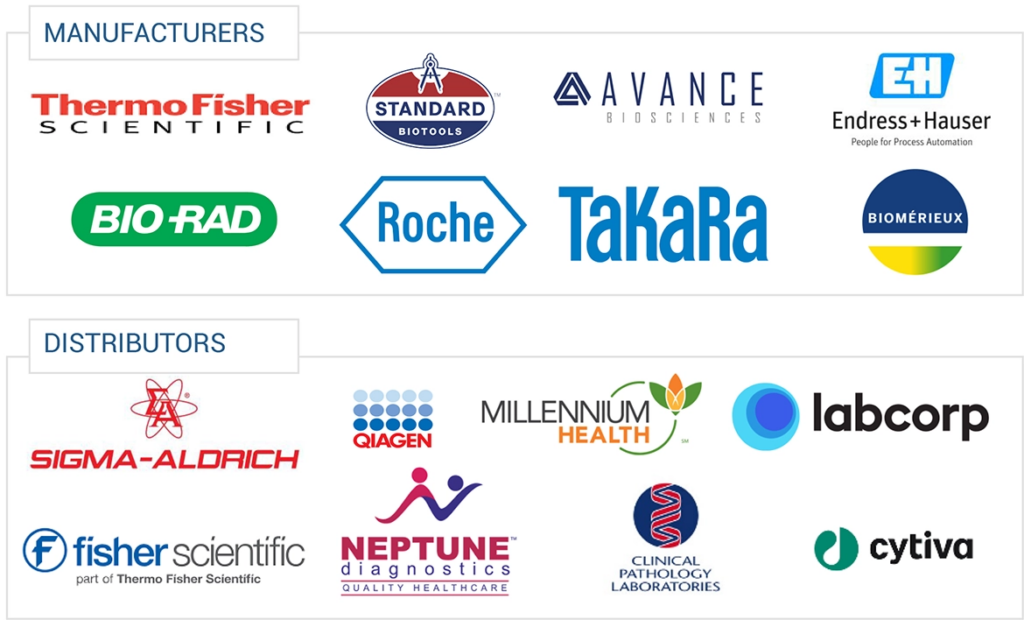The Polymerase Chain Reaction (PCR) Technologies Industry is experiencing significant growth, driven by advancements in molecular diagnostics, increased prevalence of infectious diseases, and the rising demand for personalized medicine. As of 2024, the global PCR technologies market is valued at approximately $14.61 billion and is projected to reach $21.89 billion by 2030, reflecting a Compound Annual Growth Rate (CAGR) of 7.0%.

Key Market Drivers
- Technological Advancements: Innovations such as real-time PCR (qPCR) and digital PCR (dPCR) have enhanced the sensitivity, specificity, and efficiency of PCR techniques. These advancements have expanded applications in genetic research, disease diagnostics, and personalized medicine. The integration of microfluidics and automation has further streamlined laboratory workflows, making PCR more accessible and efficient.
- Rising Prevalence of Infectious Diseases: The global increase in infectious diseases has underscored the need for rapid and accurate diagnostic tools. PCR technologies offer precise detection of pathogens, facilitating timely intervention and management. The COVID-19 pandemic, in particular, highlighted the critical role of PCR in large-scale testing and surveillance.
- Demand for Personalized Medicine: Personalized medicine tailors treatment plans based on individual genetic profiles. PCR technologies enable detailed genetic analysis, supporting the development of targeted therapies and diagnostics. This approach improves patient outcomes and drives the adoption of PCR in clinical settings.
Emerging Trends
- Digital PCR (dPCR) Expansion: dPCR offers enhanced precision in quantifying nucleic acids, making it invaluable in research and clinical diagnostics. The global digital PCR market is projected to grow from $10.0 billion in 2024 to $14.8 billion by 2029, at a CAGR of 8.1%.
- Point-of-Care Testing (PoCT) Integration: The miniaturization and automation of PCR devices have facilitated their use in point-of-care settings. This development allows for rapid, on-site diagnostics, which is crucial during public health emergencies and in remote areas with limited laboratory infrastructure.
- High-Throughput PCR Systems: The demand for large-scale testing has led to the development of high-throughput PCR systems capable of processing numerous samples simultaneously. These systems are essential in managing pandemics and large-scale research projects.
Regional Insights
- North America: Holding the largest market share of 44.5% in 2023, North America’s dominance is attributed to the high incidence of infectious diseases, robust healthcare infrastructure, and continuous technological innovations.
- Europe: The European market benefits from significant investments in healthcare and research, along with supportive regulatory frameworks that encourage the adoption of advanced PCR technologies.
- Asia-Pacific: This region is witnessing rapid market growth due to increasing healthcare expenditures, a rising patient population, and growing awareness of advanced diagnostic techniques.
Challenges
- High Costs and Technical Complexity: The premium pricing of advanced PCR equipment and the technical expertise required for operation can be barriers for smaller laboratories and clinics, particularly in developing regions.
- Regulatory Hurdles: Stringent regulatory guidelines for medical devices can delay the approval and commercialization of new PCR technologies, impacting market dynamics.
Growth Opportunities
- Emerging Markets: Developing countries present significant opportunities due to increasing investments in healthcare infrastructure and a growing focus on early disease detection and prevention.
- Technological Innovations: Ongoing research in PCR methodologies, such as the development of multiplex PCR and portable devices, offers avenues for market expansion and diversification.
- Strategic Collaborations: Partnerships between academic institutions, research organizations, and industry players can accelerate the development and adoption of novel PCR technologies.
Conclusion
The PCR technologies market is poised for sustained growth, driven by technological advancements, the increasing burden of infectious diseases, and the shift towards personalized medicine. While challenges such as high costs and regulatory complexities exist, they also pave the way for innovation and strategic initiatives. Industry stakeholders are encouraged to invest in research and development, explore emerging markets, and foster collaborations to capitalize on the evolving opportunities within this dynamic landscape.

